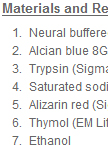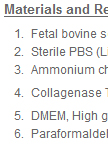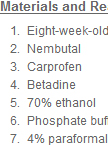Improve Research Reproducibility A Bio-protocol resource
- Protocols
- Articles and Issues
- About
- Become a Reviewer
Past Issue in 2012
Volume: 2, Issue: 8
Developmental Biology
Alcian Blue – Alizarin Red Staining of Mouse Skeleton
Our lab has used the Alcian blue – Alizarin red staining method with certain modifications to characterize skeleton deformities in mice lacking Pek/Perk, encoding a translational control eIF2alpha kinase.
Immunology
Isolation of Dendritic Cells and Macrophages from the Murine Kidneys of Lupus by Cell Sorter
Methods for the isolation and characterization of mononuclear phagocytes from the kidneys of mice with SLE are essential to understand the patho-physiology of the disease. Activation of these cells is associated with the onset of clinical disease in mice and infiltration with these cells is associated with poor prognosis in humans.An analysis of the function of these cells should lead to a better understanding of the inflammatory processes that lead to renal impairment in SLE and other renal inflammatory diseases.
Neuroscience
Stereotaxic Injection of LPS into Mouse Substantia Nigra
Stereotaxic injection is an attractive approach for studying genetic, cellular and circuit functions in the brain. Injection of anatomical tracers, site-targeted lesions and gene delivery by recombinant adeno-associated viruses and lentiviruses in mice are powerful tools to study nervous system development and disease mechanisms. Stereotaxic injection of LPS or 6-hydroxydopamine has been used to establish animal models of Parkinson’s disease, the most common neurodegenerative movement disorder. Importantly, this protocol allows the manipulation of gene expression in the targeted rodent brain regions and even targeted cell types or a subpopulation of cells in the injected region at any postnatal developmental stage up to adulthood.
Stereotaxic Infusion of LPS into Rat Substantia Nigra via Osmotic Minipump
Stereotaxic infusion of LPS or your reagent of choice is an invaluable tool for the creation of chronic site-targeted lesions. Stereotaxic infusion of LPS has been used to establish chronic animal model of Parkinson’s disease, the most common neurodegenerative movement disorder. This protocol is especially useful to established chronic disease models and to study mechanisms of chronic central nervous system diseases.







